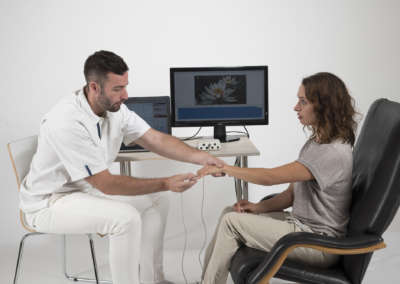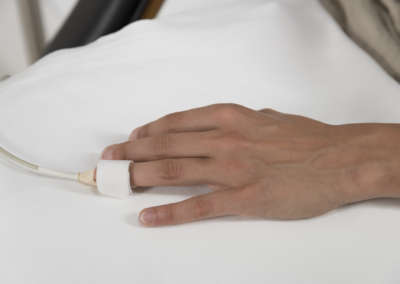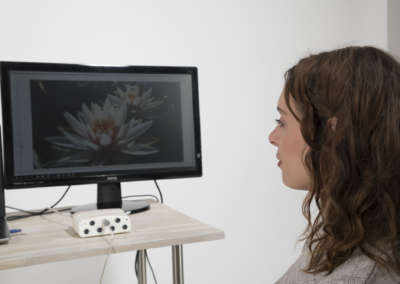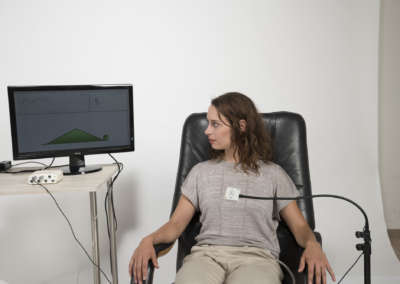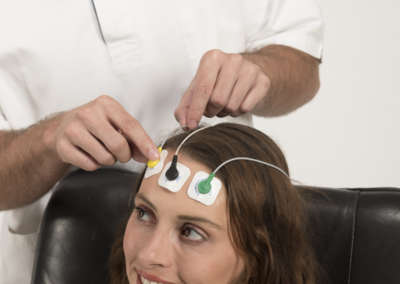From passive reception to active action
What is biofeedback?
Biofeedback is a scientific method, a learning process that enables voluntary control over otherwise unconscious bodily functions. The aim is for the patients to bring themselves back into balance, to experience themselves as self-effective and to recognise that they can change something themselves.
With biofeedback, clients learn how they can actively influence their organism in the direction of health and balance. To this end, biofeedback devices are used with sensors to record physical parameters and display them on a screen.
definition | function | parameters | applications | procedure | benefits | device
Biofeedback devices
Professional systems are able to display even the smallest changes reliably and quickly, which helps clients to better understand the close connection between thoughts, emotions and the rest of the organism. Our Neuromaster system fulfils all these requirements and combines them with a particularly high level of user-friendliness.
Biofeedback: how does it work?
To understand how biofeedback works and how it can help patients, it is helpful to first realise how difficult it is to control our bodily functions or even perceive them. With breathing, for example, this may still be possible to a certain extent, but with values such as the tension of our muscles or the sweating of our hands, we quickly reach our limits. In itself, the unconscious running of such functions is often helpful, but many symptoms (such as stress, pain, ADHD) can be positively influenced if the organism can be actively controlled.
This is where biofeedback devices come into play. These use sensors to record and visualise the very parameters that clients can barely perceive. For example, a finger sensor can precisely record the skin conductance (the activity of the skin’s sweat glands), a value whose increase is associated with stress. The client perceives the value via a screen and observes how he can influence it (e.g. through pleasant memories or methods such as autogenic training).
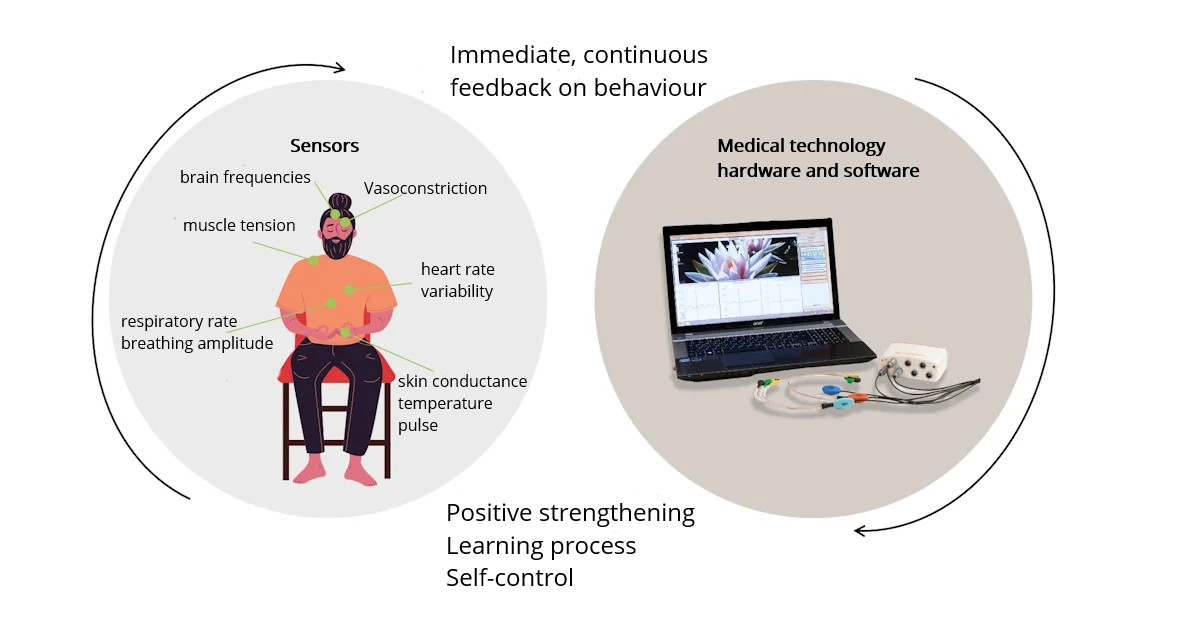
An “aha” experience
The experience of the first biofeedback session is often a classic “aha moment” for clients, as they learn for the first time what influence thoughts and emotions can have on the body. The classic “I’m not stressed” model of many clients is also revised here.
After a certain training period (typically no more than 5-10 sessions, depending on the severity of the problem), the client learns to use this skill in everyday life without the device so that they are no longer dependent on the device and can actively counteract their problems.
Biofeedback is a way out of helplessness in the face of illness and complaints – the client is transformed from a passive recipient into an active agent.
PARAMETERS
What is being measured?
A wide variety of parameters are usually measured during biofeedback. In any case, it is advisable to derive several parameters simultaneously in order to understand the interplay of the organism.
Skin conductance
Skin conductance is a measure of the electrical conductivity of the skin and is a measure of sympathetic activity. Skin conductance is therefore also referred to as “the window to the sympathetic nervous system”, as it is an expression of psychological activation.
It will very often be the first biofeedback parameter that subjects are introduced to. This is because it is an ideal measure of stress and relaxation and reacts very quickly.
It is used both in the assessment of stress (biofeedback analysis) and in training. In the latter, the test subjects learn to actively lower their skin conductance and thus achieve relaxation.
Temperature
Temperature is a measure of peripheral blood flow in the direction of relaxation. It is measured in degrees Celsius (°C) and depends on the extent of blood flow.
Temperature biofeedback is all about learning the ability to actively warm the temperature of the fingers. This effect spreads and is not regionally limited to the fingers. This value is also considered a good indicator of stress and relaxation, but it reacts more slowly than, for example, skin conductance. Temperature training is often combined with autogenic training (another relaxation technique) to enhance the effects of the method.
Muscle tension
A popular variant of biofeedback involves training muscle tension. One of the reasons for this is that tension (which often results in pain) in this area is a problem for many people. The aim of EMG training is therefore usually to reduce muscle tension.
However, the feedback from muscle tension can also be used to retrain weak muscles. The most popular variant of this training is probably pelvic floor training for incontinence or erectile dysfunction.
Breathing
The aim of respiratory training is to practise slow and deep abdominal breathing with clients. The pleasant thing about breathing biofeedback is that this parameter is quite easy to control for most people. We record breathing using a non-contact infrared sensor.
Respiratory biofeedback has been shown to be highly effective in the area of disorders such as anxiety and PTSD, but is also used for many different problems (such as general stress, burnout, depression or asthma).
Heart rate variability
Ein gesunder Herzschlag zeichnet sich nicht durch starre Regelmäßigkeit aus, sondern durch gewisse Variationen in seinem Rhythmus. Solche Variationen entstehen durch Erleben von Emotionen und Gedanken oder auch einfach durch die Atmung.
Ein gesundes Herz verfügt über die Fähigkeit sich an innere und äußere Einflüsse anzupassen, eine Einschränkung dieser Fähigkeit zeigt sich in verschiedenen Krankheitsbildern wie z.B der Depression. Beim HRV-Biofeedback wird sowohl, die Herzratenvariabilität analysiert (wo stehe ich?) als auch trainiert (Ausbau der Anpassungsfähigkeit des Herzens).
A healthy heartbeat is not characterised by rigid regularity, but by certain variations in its rhythm. Such variations are caused by experiencing emotions and thoughts or simply by breathing.
A healthy heart has the ability to adapt to internal and external influences; a restriction of this ability is reflected in various clinical pictures such as depression. HRV biofeedback involves both analysing heart rate variability (where am I?) and training (improving the heart’s ability to adapt).
EEG (Neurofeedback)
In technical terms, neurofeedback is a sub-category of biofeedback in which brain activity is influenced. In practice and science, however, the two methods are usually referred to separately.
Frequency band training (the most common type of neurofeedback application) involves learning to influence the activity of frequency bands of the EEG. These bands are associated with different states, e.g:
- Alpha band: relaxation
- Theta band: sleepiness/daydreaming
- Beta band: attention/activity
- etc.
The best-known application of neurofeedback is in the treatment of ADHD (learning to increase activity in the beta band and reduce activity in the theta band). However, the method is also becoming increasingly popular in non-clinical areas (e.g. in elite sport).
Peripheral blood flow (vasoconstriction)
A special variant of biofeedback is known as vasoconstriction training. Clients learn to voluntarily influence the blood flow in their temporal artery (which is thought to play a central role in migraines).
This variant is used in migraine therapy. When an attack occurs, the client can influence the temporal artery so that it is intercepted.
Application and effectiveness
The areas of application of biofeedback are almost unlimited due to the diversity of the sensors. This method is primarily used in the fields of psychosomatics, pain therapy, psychology, and psychotherapy. However, it is also increasingly being used outside the clinical field, for example to improve performance in sport and at work, as well as in training and coaching.
There are numerous reports from practitioners and extensive scientific literature that prove the effectiveness of biofeedback and neurofeedback. In a review conducted by the US AAPB (Association for Applied Psychophysiology and Biofeedback) in 2023, many areas of application were classified on a scale from ‘effective and specific’ to ‘possibly effective’.
Source: Khazan, I., Shaffer, F., Moss, D., Lyne, R. & Rosenthal, S. (2023). Evidence-Based practice in biofeedback and neurofeedback.
Effective and specific:
- attention deficit hyperactivity disorder (ADHD)
- panic disorders
- asthma
- depression
- Diabetes mellitus
- Erectile dysfunction
- Incontinence (adults)
- Pre-eclampsia
Effective:
- Headache
- Chronic back pain
- High blood pressure
- Irritable bowel syndrome
- Post-traumatic stress disorder (PTSD)
- Raynaud’s syndrome
- Temporomandibular dysfunction (TMD)
- Cerebral palsy
- Stroke
- epilepsy
- Peak performance
- Incontinence (children)
Probably effective:
- Alcohol and drug addiction, among others
- Fibromyalgia
- Generalised anxiety disorder (GAS)
- Arthritis
- Autism
- Tinnitus
- Chemotherapy-induced peripheral neuropathy
- Chronic obstructive pulmonary disease (COPD)
- Tumour pain
- Phantom limb pain
- Coronary heart disease
Potentially effective:
- Specific phobias
- Chemobrain
- Functional abdominal pain
- Hyperhidrosis
- Vasovagal syncope
BIOFEEDBACK THERAPY
Procedure and duration
Biofeedback treatments usually follow a very similar pattern. In the first session, the client learns all the basics about the principle of the method and is introduced to the organism’s reaction to stress and relaxation by means of simple line representations (e.g. a line for skin conductance, which increases under stress).
A stress and recovery profile is then carried out (also known as a stress test). This involves observing the body’s reaction to stress as well as the relaxation phase. The data collected then forms the basis for drawing up the biofeedback therapy plan.
During the training itself, the client sits in a comfortable armchair, is connected to a biofeedback device and sees their bodily functions on the screen via the software or receives instructions. The session lasts around 20 minutes and is followed by an interpretation or discussion of the recorded biofeedback parameters.
On average, between 4 and 18 sessions are carried out (the number of sessions depends on the type and extent of the illness). It is advisable to set a target criterion before the treatment and to carry out the treatment until this target is reached.
Ultimately, the client should learn to influence their organism even without feedback from the devices.
Biofeedback analysis – the stress test
The first biofeedback session is usually a stress and recovery profile, also known as a “stress test”. The aim of this stress test is to assess the client’s reaction to various stressors (mental arithmetic, strenuous noise, talking about stressful situations) and also to determine how well the client can recover after these stressors. To do this, the client goes through phases of exertion and recovery.
The stress profile is used to answer the following questions, among others:
Which body system reacts most strongly to psychological stress?
Which body system shows a delayed recovery after the stressor?
What content produces the greatest physiological stress reaction or relaxation?
Exemplary stress tests
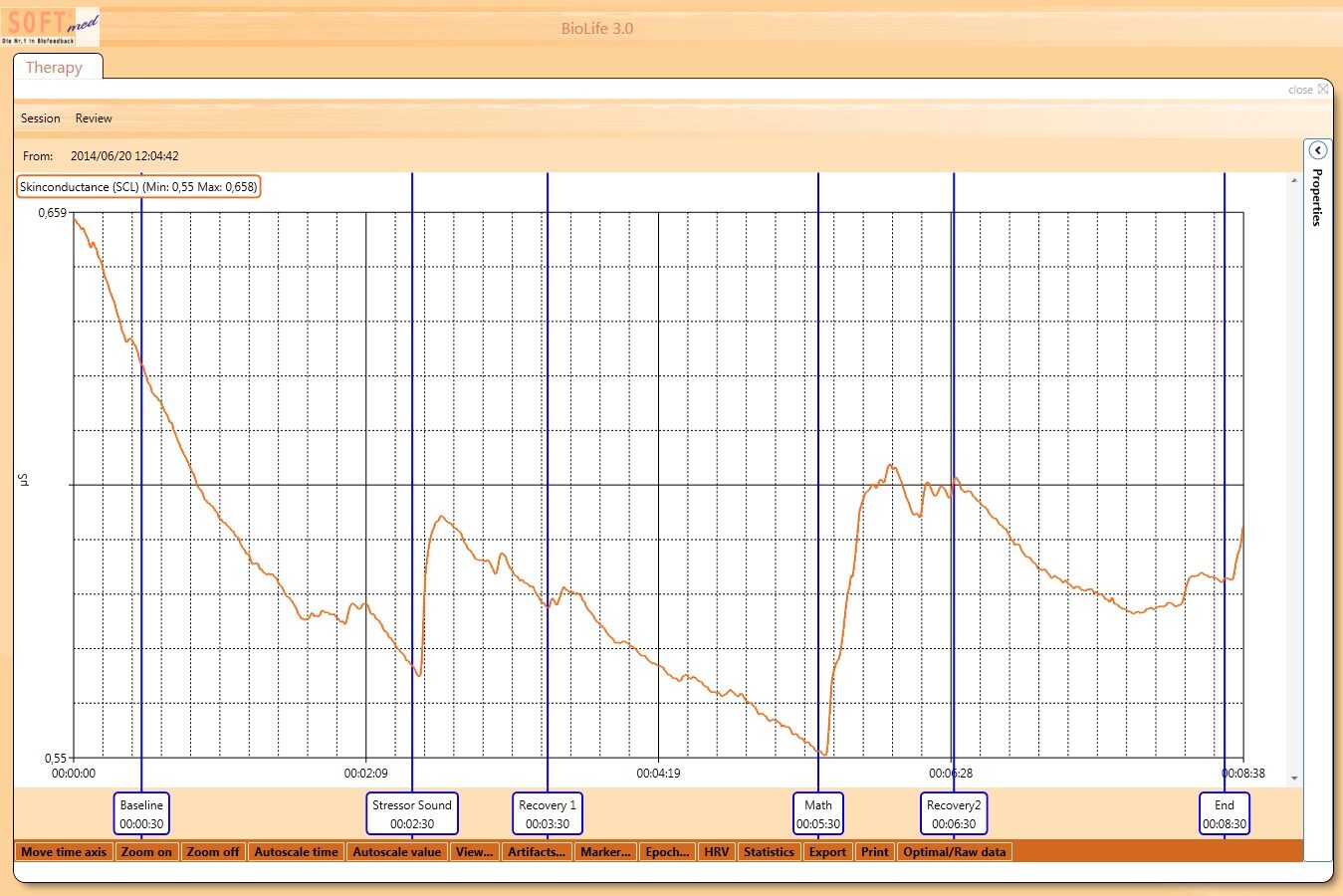
An inconspicuous stress test
Here we see how the client’s skin conductance parameter increases during “stressors”. This should be seen as positive (a certain amount of stress during exertion is normal and healthy). After the stressor ends, the subject can relax again. A high initial value, as we see here, can often be experienced with test subjects during their first sessions; this is often due to nervousness and subsides during the baseline phase (phase 1).
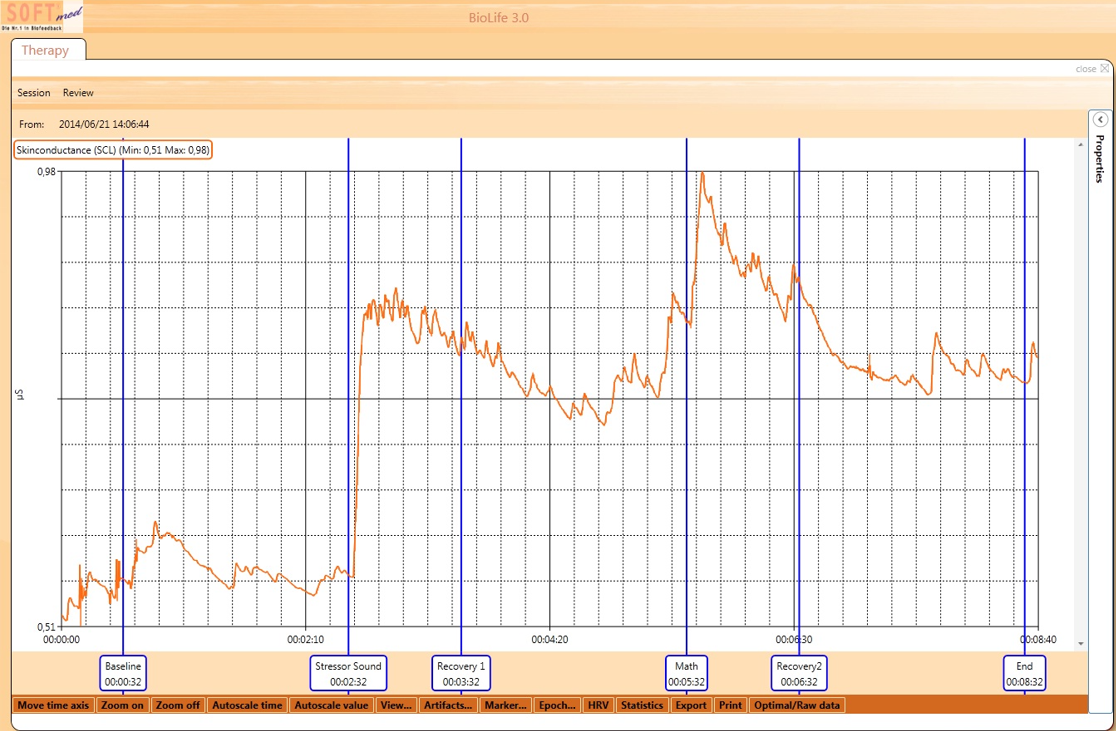
A conspicuous stress test
During the stress phases, the test person shows a very strong reaction. What is particularly noticeable, however, is that the increased stress parameters are not reduced again in the recovery phase. They remain high and the second stress phase then more or less builds on the first and further increases the stress. Even after a further relaxation phase at the end of the session, the subject’s stress value remains at a much higher level than at the beginning of the session.
Benefits of the biofeedback method
Insight
Using biofeedback, clients gain insight into their organism. This is particularly helpful in convincing sceptics of the need for action through scientific proof.
The right method
Biofeedback can be used to objectively work out which of the countless relaxation techniques works best for clients.
Taking controll
Biofeedback is used to learn the ability to actively influence one’s own body. This helps to regain a sense of self-control.
Motivation
Visualising the progress of the therapy can be a key motivational component, especially when techniques require some time to get started (e.g. autogenic training) or when the training itself takes a long time (e.g. in rehabilitation).
Analysis
Clients and therapists can work together to find out how the subject’s individual organism reacts to stress.
Monitoring progress
Monitoring progress is not only beneficial for the client (who can observe his progress session by session), but also for the therapist himself, who can review his approach and adjust the therapy plan if necessary.
Risks and side effects
No risks or side effects are known for the (non-drug) biofeedback treatment itself. Only “positive side effects” have been reported in practice (treatment also had a positive effect on areas of life that were not part of the original treatment).
In the case of serious mental disorders (e.g. paranoid schizophrenia) or if there is a risk of flashbacks due to deep relaxation, caution should be exercised according to the literature.
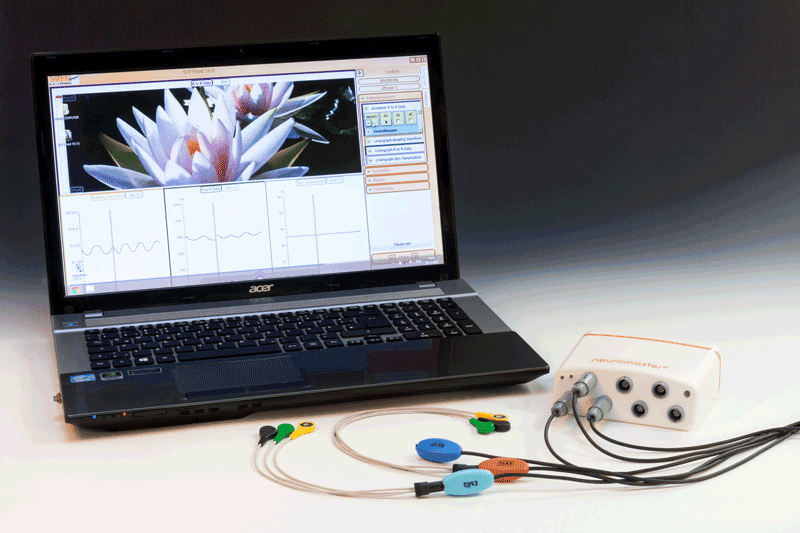
Biofeedback devices
If you summarise the different types of systems, you can roughly speak of two categories: Small home devices, and professional systems for biofeedback and neurofeedback training. Professional systems can display even the smallest changes reliably and quickly, which helps clients to better understand the close connection between thoughts, emotions, and the rest of the organism. The Neuromaster system fulfils all these requirements and combines them with a particularly high level of user-friendliness.
Small home devices and apps are not suitable for biofeedback therapy in a practice or clinic, and above all, are not approved for this purpose (certification as a medical device is a prerequisite for the legal use of a therapy device on patients).
Ready for more information?
Request free and non-binding informational materials from Biofeedback and Neurofeedback!
You will receive:
- Information brochure about Neuromaster and its benefits
- Fields of Application of Neuromaster
- Personal consultation via phone or Zoom, if desired: please provide your preferred date and time in the form.

